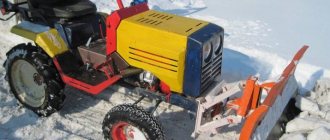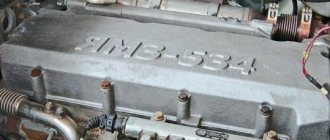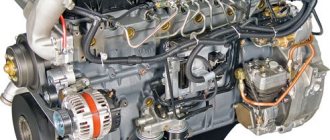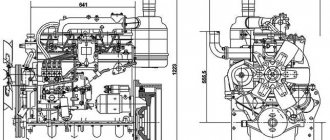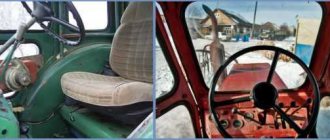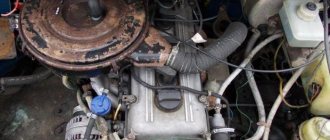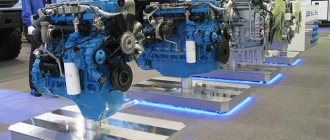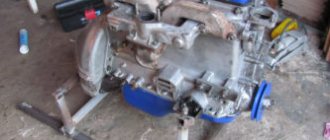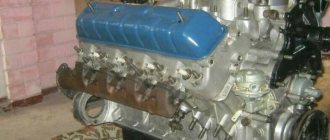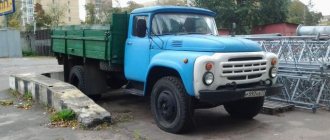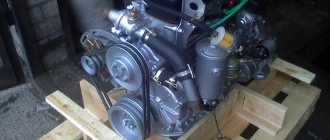Products manufactured at the Yaroslavl Motor Plant are very popular among the world's famous automakers, thanks to their excellent technical characteristics and high quality workmanship. Along with the new engines included in the line of modern diesel engines, the YaMZ 536 engine began production in 2012. YaMZ 536 is the basic design for creating modifications 536.10, 5361, 53625, etc. They differ in the adjustments and settings of electronics and fuel equipment. Diesel units of the 236 family are the result of progressive developments by the plant team.
Cars and tractors with YaMZ 536
The six-cylinder YaMZ 536 turned out to be more powerful and economical, based on the volume of the internal combustion engine. As a result, diesel quickly gained credibility among many manufacturers of various equipment and was installed on trucks: Ural, GAZ, MAZ, ZIL, tractors: Onega, Altai, Vologda, Chelyabinsk, Lipetsk, Vladimir tractor plants. The motor was also used on medium and small capacity buses: Volzhanin, PAZ, LiAZ, KAVZ, combine harvesters: Krasnoyarsk, Rostselmash and Taganrog plants. YaMZ536 was also used by the Ministry of Defense to complete tracked and wheeled vehicles, on stationary installations and other products.
Engine Operation and Maintenance
To maintain technical characteristics during engine operation, reliable and long-term operation, it is necessary to comply with the rules and standards for servicing the power unit established by the manufacturer. The document regulating these works is the YaMZ-536 operating manual. It can be divided into the following large sections, which describe:
- Motor specifications.
- Operating principles and main structure of the engine.
- Applied technological materials and liquids.
- Rules for performing work processes during operation of the YaMZ-536 (start, operation, stop).
- Maintenance requirements and frequency.
- The procedure for diagnosing faults and ways to eliminate them.
- Various reference information.
Knowledge and compliance with the manufacturer's requirements guarantees reliable operation of the engine.
History of the creation of YaMZ 536
The modern, four-stroke diesel engine belongs to the line of engines of the 530 family of the Yaroslavl plant. This family is represented by two main models: YaMZ534 and 536. These engines are considered by some experts to be updated models 204 and 206 engines of the Yaroslavl plant. But this judgment is extremely incorrect. The old engines were two-stroke, they were replaced by four-stroke, V-shaped diesel engines back in 1962. Soon they completely replaced the obsolete two-stroke engines of the 204 and 206 models from production. At this time, no one had even thought about the 530 family of diesel engines. The only thing that the 536 and 206 engines have in common is the number of cylinders; otherwise, these are completely different models.
The family of 530 engines at Avtodiesel was developed from a new sheet of paper. And the world-leading Austrian engineering and design corporation AVL List was involved in upgrading the new engine to world standards. Participation in the development of a new engine from a well-known engineering company meant that the new diesel engine began to comply with European environmental safety standards Euro 4, with the possibility of finalizing Euro 6 standards.
The legendary development of the YaMZ 530 family began back in 1992. Then, three leading automobile manufacturing plants in Russia: YaMZ, GAZ, ZMZ agreed to develop a new diesel, four-stroke engine for medium-sized PAZ buses and GAZ trucks.
It was decided to carry out design work in the city of Yaroslavl, and they decided to launch serial production in the Volga region. First they wanted to create a four-cylinder engine, and then on its basis, by adding two cylinders, to design a six-cylinder, modern diesel engine. Initially, it was decided to use a gas distribution mechanism with four valves in each cylinder and separate cylinder heads.
In the first developments of the engine, a mechanical, in-line injection pump was used; later they decided to use individual high-pressure injection pumps in the fuel system; they were located inside the BC. These first engines were equipped with a turbine and were planned to be used for buses of the Gorky and Pavlovsk factories. The estimated maximum diesel power at the border is 140 hp. But this motor was not completed. Market needs have changed. The multi-purpose military vehicle GAZ 3937, created on the basis of an armored personnel carrier, required an engine whose power should not be less than 170 hp. It was for this car that the first diesel engine of the new generation was created. It received the YaMZ 460 marking.
By 2001, based on this internal combustion engine, three diesel versions were developed: with three, four and six cylinders. These were: three-cylinder, with a power of 110 hp, four-cylinder, with a power of 160 hp, and the hero of our story, YaMZ 536. All created engines underwent laboratory tests on domestic vehicles. YaMZ 536 exceeded all expectations; it turned out to be a serious engine with a power of 240 hp. It was tested on a LIAZ bus and a Ural truck.
In 2003, Russian engineers turned to engineers from the leading Austrian company AVL List for an audit of the technical data of new diesel engines. Foreign experts noted the high level of new engines. And in 2005, a joint design group was created in Yaroslavl to improve the YaMZ530 engines to world standards. The group worked in the Austrian design center in the city of Graz. And a year later, in 2006, the new YaMZ 536, with a capacity of 312 hp, was tested. Cooperation with Austrian specialists made it possible to create a diesel engine that complied with Euro 3 and Euro 4. Serial production was supposed to begin in 2009, but the crisis that broke out confused all plans. But all the bad things pass, and thanks to a loan from Vnesheconombank in May 2010, the construction of new industrial buildings was resumed. And a year later it was completed, including installation of equipment. At the end of 2012, YaMZ536 entered mass production.
About the history of the model
Diesel engines of the YaMZ-5Z0 family were the result of cooperation between the Yaroslavl Motor Plant and Austrian specialists. As a result, at the beginning of the 2000s, four- (YaMZ-5Z4) and six-cylinder (YaMZ-5Z6) diesel engines were developed and created, which were not inferior to modern foreign analogues in terms of efficiency, noise, and environmental friendliness. And also their variants running on liquefied gas.
By 2009, a pilot batch of engines of the 5Z0 family was produced for bench and road tests, and the construction of a new “plant within a plant” for the production of these modern engines was completed. The opening of this plant took place at the end of 2011, and from 2012, YaMZ-5Z6 engines began to be equipped with new cars and buses. The design capacity of the new plant for the production of YaMZ-5Z6 engines is 50 thousand engines per year.
Modifications of the YaMZ 536 power unit
During production, a large number of analogues and modifications of the base engine were developed. The engine was adapted for different types of equipment, which is why many versions of the 536 ICE appeared. The main difference between all versions of the internal combustion engine is different ECU software, which changes the settings for the operation of the fuel injection pump.
Here is a list of the main modifications:
YaMZ 536
The base power unit is considered to be the YaMZ536. Its power, 2300 rpm, is 312 hp, and the torque at 1500 rpm is 1226 Nm. The base engine is installed on a MAZ truck: 6312, 5363, 5550, 5440; Ural 6370. It was also used on LiAZ 6212, 5256, 6213 buses. The base power unit complies with EURO 4 environmental safety parameters.
The base engine had several analogues:
- YaMZ-53601, a close copy of the main engine, it used the EOBD II system. This version was equipped with MAZ cars: 5440, 6312, 5363, 5550, 6501; as well as LiAZ buses: 6212, 5256, 6213;
- another analogue of the base engine is YaMZ-53602, there is no valve that recirculates exhaust gases, here the design of the exhaust tract has been changed and the ECU settings have been changed. This analogue of the base motor corresponds to the 4th environmental class according to rules 96-02. YaMZ-53602 is used on Ural-NEXT trucks: 4420, 4320, 5557; on boats: KS 951, 162, 165, 950, 164, 169; Ameta, Flagship;
- another analogue of the main engine, labeled YaMZ-53603. It uses the EOBD II system and an SCR catalyst, thanks to which this version complies with EURO 5. The diesel power has increased at 2300 rpm to 330 hp, and the torque at 1500 rpm is 1275 Nm;
- YaMZ-53604, an analogue of the main engine, running on gas.
YaMZ 5361
The YaMZ 5361 modification differs from the base engine by setting the injection pump to 270 hp, power at the same crankshaft speed, the torque has correspondingly decreased to 1166 Nm, at 1500 rpm. The motor was used on a MAZ truck: 5440, 6312, 5363, 5550.
This modification also has its analogues:
- YaMZ 53611, an analogue of the previous modification, differs from it in the installed EOBD 2 system. Diesel was found on the same MAZ models as YaMZ 5361;
- YaMZ-536111, this is a version of YaMZ 53611, used on LiAZ 5293 and LiAZ 5292 buses;
- YaMZ-53613 is an analogue of the base engine, converted to EURO 5. An SCR catalyst and EOBD2 are installed here. This internal combustion engine is intended for LiAZ buses: 6212, 5256, 6213.
YaMZ 5362
A modification that was designed for the Ural truck. But later it was installed on other vehicles, such as: LiAZ5292, 5256, 5293; and at ChSDMDZ-98.
The YaMZ 5362 modification had its own analogues and copies:
- YaMZ 53621, copy of 5362, but with EOBD;
- YaMZ 53622, the same 5362, but with a TKR80.05.13 turbine installed, without an EGR valve, with a modified intake pipe design. The motor complies with the 4th environmental class, according to rules 96-02. The engine was equipped with the Ural Next: 4320, 5831, 3255, 5557;
- YaMZ 53623, version for EURO 5, power at 2300 rpm min., 275 hp, and torque at 1500 rpm min., 1177 Nm.
- YaMZ 53624, version 5362, running on gas, its power is 287 hp.
YaMZ 5363
Modification for KrAZ and MAZ trucks. The power of this version at 2300 rpm min., 240 l., forces, torque at 1500 l., forces, is 1049 Nm. The power unit was installed on the MAZ 5550 and MAZ 5363.
In the fourth modification, there were also analogues:
- YaMZ 53631, copy 5363 with EOBD2 system;
- YaMZ 53633, version, customized for turbocharger. Used on the LiAZ5292 bus.
- YaMZ 5364, a modification specially created for the LiAZ 6213 and LiAZ 6212 buses. Engine power, at 2300 rpm min., 285 hp, power. Torque 1130 at 1500 rpm min.
The modification has a number of copies:
- YaMZ 53642, copy 5364, it lacks an EGR valve, a TKR80.05.13 turbocharger is installed and the design of the intake pipe has been changed. The engine is used on a KrAZ 4420, 5831, 4320, 5551, 5557 vehicle, complies with EURO 4;
- YaMZ 53644, gas version of the internal combustion engine, its power is 260 hp.
- YaMZ 53645, analogue of 53642, is adapted for use on tractors and combines;
- YaMZ-53646, analogue of 53642, with reduced power of about 202 hp. Used on RM-Terex TX 270 and WX 202.
YaMZ-5366
Tractor modification for environmental class 4, in accordance with safety rules 96-02. The power of the power unit is 262 hp. The motor used is RM-TerexTG200.
The modification is no exception regarding the presence of analogues:
- modification YaMZ-53662, is a copy of 5366. Its power is 219 hp. The motor used is RMTerexTG 180;
- YaMZ-53663, an analogue for EURO 5, has 246 hp, power, used on LiAZ 5292, 5262, 5293 buses.
YaMZ 5368
YaMZ 5368 is a version of the basic model, adapted to operate diesel generators.
general information
YaMZ-536 is the basic 6-cylinder model of the in-line YaMZ-530 family.
Modifications YaMZ-536-10 (-30, -40), YaMZ-5361, YaMZ-5362, YaMZ-5363, YaMZ-5364 are structurally similar to the base model, differ in fuel equipment adjustments by changing the settings of the electronic control unit. Engines of the YaMZ-530 family in terms of emissions of harmful substances comply with the Special Technical Regulations “On the requirements for emissions of harmful (pollutant) substances from automotive equipment produced in circulation on the territory of the Russian Federation”, environmental class Euro-4:
To achieve the Euro-4 environmental level, an EGR (exhaust gas recirculation) system and a catalytic converter with a replaceable filter are used. The parameters of Rule No. 96-02 are achieved without the use of an EGR system and a converter.
- for road equipment - UNECE Regulations No. 49RII-04, No. 24-03.
- for off-road vehicles - UNECE Regulations No. 96-02, No. 24-03.
Main characteristics
Engine type: diesel, 6-cylinder, D×S=105×128 mm, displacement 6.65 l, 4-stroke, in-line, with rear gear drive units, liquid cooling system, turbocharging and charge air cooling in a “type” heat exchanger air-to-air" installed on the vehicle.
Description of the power unit corresponding to EURO 4 and EURO 5
The new YaMZ 536 diesel units and its modifications comply with the European requirements for exhaust gas purification EURO 4 and EURO 5. To meet these requirements, an exhaust gas recirculation system (EGR for short) was included in the design of the new engine. It was also planned to install a catalytic converter, which was equipped with a filter that required periodic replacement. All these devices were needed to comply with EURO 4. The engine complied with the parameters of rules 96-02 even without this.
The engines of the 536 model, complying with EURO 5, have been further developed. For this purpose, as on imported cars, the exhaust system was equipped with a selective catalytic reducer, a catalytic converter and a muffler converter. The motor power supply and control system was a Common rail battery type, it had high injection energy, up to 1800 bar. The control system was used from Bosch. The power supply system included: high pressure HP, fuel accumulator line, ramp, injectors, dosing module. The fuel supply system had several control sensors: a crankshaft phase detection sensor, a rotation speed sensor, a sensor indicating fuel pressure, an air temperature sensor coming from the turbine, a sensor measuring fuel temperature, a sensor indicating coolant temperature and a motor lubrication pressure sensor.
The cylinder block, cylinder head, crankshaft, connecting rod mechanism, bearings of the YaMZ-536 engine, and other important internal combustion engine mechanisms are designed for a fuel ignition pressure of 210 bar. All components and mechanisms are designed with a large margin of safety and the possibility of increasing motor power.
The drive of gear-type units is located on the flywheel side. It provides low noise level of torsional vibrations. YaMZ 536 has a closed ventilation system for crankcase gases; its design is located in the cylinder head cover; it does not require maintenance or constant care.
Development of diesel production
In the first time after its creation, the engine plant continued to produce two-stroke engines models 204 and 206. At the same time, new promising diesel units were being developed. The result of this work was a series of YaMZ-236, 238, 240 engines.
At the beginning of production, new engines were considered modern and had high technical characteristics, which ensured widespread use of these units. They were installed on MAZ, KRAZ, ZIL, URAL trucks, bulldozers, tractors, military and construction equipment.
The main feature of these engines was considered to be an increase in power due to an increase in the number of cylinders. At the same time, there was a significant unification of engines, ensuring high maintainability of these power units. Currently, after a large number of upgrades, the company continues to produce these engines in almost three hundred configuration options.
In the early seventies, the company developed and produced a family of heavy-duty engines of the YaMZ-840 series for BELAZ, MoAZ vehicles and special equipment. Subsequently, the production of these engines was transferred to the Tutaevsky plant.
Technical data YaMZ 536
The four-stroke, six-cylinder, diesel engine YaMZ 536, the cylinders of which are placed in one row, was released in 2012. Its production began at the Avtodiesel enterprise, Yaroslavl Motor Plant.
- Material of manufacture, especially durable cast iron. The liners are wet type and have direct contact with the coolant.
- The gas distribution system is lower shaft, the camshaft is located in the BC. Gear drive, from the crankshaft. The camshaft acts on the valve rocker arms using push rods. There are 24 valves, 4 for each individual cylinder.
- The piston stroke length is greater than the cylinder diameter: 128 and 105 mm, respectively. Motors with such parameters are considered long-stroke; their peculiarity is that they have a high efficiency output.
- The exact engine capacity is 6650 cubic centimeters, the compression ratio of the combustion chamber is 17.5:1.
- Engine power, depending on the modification, at 2300 rpm, from 212 to 330 hp, torque at 1500 rpm, ranges from 950 to 1275 Nm.
- Environmental compliance standards with European environmental safety standards EURO 4, EURO 5.
- On certain modifications, a TKR80.05.13 turbocharger is installed.
- The weight of the power unit is 650 kg.
Fuel consumption
Fuel consumption at a speed of 60 kilometers per hour is about 30 liters per 100 kilometers. The permissible consumption of motor lubricant is up to 0.2% of fuel consumption.
Oil
Engine oil: 10W40, 5W40, 15W40. The amount of oil is 22.5 liters. The manufacturer recommends changing the oil after 30 thousand km, but it is better to cut this period in half.
Engine life
The actual service life of an internal combustion engine with proper, timely maintenance and normal operation is about 1 million km.
Technical characteristics of YaMZ-5Z6 and its modifications in numbers
- Overall dimensions - car: length 1298 / width 759 / height 972 mm, bus: length 1154 / width 762 / height 880 mm.
- Working volume – 6.65 l.
- Cylinder diameter – 105 mm, piston stroke – 128 mm.
- Compression ratio - 17.5.
- Rated rotation speed – 23ОО rpm.
- Power – 229 kW (312 hp) – in the base “YaMZ-5Z6” and modifications “YaMZ-5Z6-1O” (-3O, -4O), “YaMZ-5Z602-1O”; 198.5 kW (27О hp) – “YaMZ-5Z61”; 176.5 kW (240 hp) - “YAMZ-5Z62”, “YAMZ-5Z62-1O”, “YAMZ-5Z63”, “YAMZ-5Z622-1O”; 21O kW (285 hp) - “YaMZ-5Z64”, “YaMZ-5Z64-1O” and “YaMZ-5Z642-1O”.
- Maximum torque – 1226 N•m (125 (kgf•m) – for modifications with a capacity of 312 hp; 1166 N•m (119kgf•m) – for 27O-horsepower; 9OO N•m (92kgf•m) – for a power of 240 hp (for the YaMZ-5Z6Z modification this figure is 1049 N•m (107 kgf•m); 113О N•m (115 kgf•m) – for 285 hp engine options.
- Rotation speed at maximum torque – from 1300 to 1600 rpm.
- The minimum specific consumption of diesel fuel is 195 g/(kW•h) / 143 g/(hp•h).
- Diesel fuel consumption at rated power is 213.5 g/(kW•h) / 157 g/(hp•h).
- Hourly fuel consumption at rated power is no more than 50.5 kg/h.
- Relative oil consumption for waste is no more than 0.2% of fuel consumption.
- The operating order of the cylinders is 1 – 5 – 3 – 6 – 2 – 4.
- Engine weight – from 62О to 64О kg, depending on modification.
- The weight of the engine with clutch is on average 9OO kg.
- The operating life of the engine before major overhaul, established by the manufacturer, is from 800 thousand to 1 million kilometers.
Design features of the YaMZ 536 internal combustion engine cylinder block
BC YaMZ 536 is made of gray, highly durable cast iron. It is the basis for connecting all components and mechanisms into a single power plant. At the top of the block there are slots for wet cartridges. Each socket in the cylinder has an annular groove in the upper part under the edge of the liner and a corresponding hole on the lower shelf of the block.
The groove and hole are made coaxially. The material used to manufacture the sleeves is phosphorous cast iron. The sleeves in the block are centered along the outer edge of the collar. The edges of the water jacket form a closed contour around the socket in the cylinder. Thus, the lower and upper plates of the cylinder parts of the BC are connected, strengthening the overall structure of the block.
Reviews on the use of diesel
The 536 engine has an in-line cylinder arrangement. This design of the power unit traditionally has the following advantages compared to the V-shaped design:
- simpler designs;
- reduced manufacturing costs;
- less weight;
- high balance.
Owners and drivers of cars highlight the following advantages of a diesel engine during operation in their reviews of the YaMZ-536:
- the possibility of using domestic consumables;
- good maintainability and ease of maintenance;
- high-quality technical characteristics;
- smooth and quiet operation;
- high reliability;
- confident work in winter.
In addition, it is necessary to note the low cost of the motor compared to foreign analogues.
Due to their design features and technical characteristics, YaMZ-536 diesel engines are modern power units for use in various vehicles, as well as industrial equipment.
Cylinder head device 536 model
The cylinder head is a block type and is common to all six cylinders. The material used is a special cast iron alloy. The cylinder head is attached to the BC using a bolted connection.
To cool the cylinder head, a system of cavities is provided for the circulation of coolant. The cylinder head contains: valves with bushings and springs, traverses, valve rocker arms, injectors and rocker arms. All these assembled parts are a single mechanism designed to supply the combustible mixture to the combustion chambers of the internal combustion engine.
crank mechanism
The crankshaft of the internal combustion engine is made together with counterweights from stamped steel. It is a dynamically balanced fully supported mechanism with hardened connecting rods and main journals. The crankshaft is installed with main shafts on the BC supports.
Between the supports and the main journals there are sliding bearings. Lubricant is supplied to the sliding bearings under pressure through special oil lines. The flywheel is cast from gray, highly durable cast iron. A steel ring gear is pressed onto it. It is necessary to start the engine with the starter. The flywheel is attached to the end of the crankshaft using ten bolts.
A common hardened plate is installed between the end and the flywheel. To dampen torsional vibrations, a liquid damper is used; a pulley is built into it at the rear for temporary drive of auxiliary units. This device copes well with the task assigned to it, but it is vulnerable; mechanical damage can quickly render it unusable.
The design of the connecting rod is made in the form of an I-beam. The lower head has an oblique connector. To increase the load-bearing capacity of the connecting rod, the upper head was made in the form of steps; near the rod it is wider. The sliding bearings of the connecting rod and main journals of the crankshaft have a removable design.
Design features of the YaMZ 536 piston group
The piston has a one-piece design. It has three grooves machined for piston rings. The groove of the upper compression ring has an insert made of especially durable cast iron. To increase the contact strength of the pistons, the pin bosses were made in the form of steps. The bottom is shorter than the top. The combustion chamber is located centrally, coaxially with the piston surface. To ensure good cooling of the piston, there is a closed cavity in its head in which oil circulates.
Oil enters the piston by fixed nozzles, which are installed on the central oil line of the BC, opposite all six pistons. In the oil cavity of the pistons, two identical channels are provided, having a vertical arrangement. The purpose of these channels is to supply and drain oil into the piston cavities. Constant circulation of oil in the piston cavity ensures reliable cooling.
The piston rings are split, cast iron, they are installed in grooves specially prepared for them. The piston pin is hollow, steel, floating type. This means that it moves freely in the piston bosses. Which has a positive effect on the operating life of the ShPG. Axial movement of the pin is prevented using retaining rings located in the grooves of the piston bosses.
Design and arrangement of the gas distribution mechanism
The gas distribution mechanism has an upper valve arrangement and a lower crankshaft arrangement. The valves are driven using pushers, rocker arms, rods and traverses. The gas distribution mechanism performs the task of admitting air into the cylinders and exhausting exhaust gases, according to the operating order of the cylinders and changing engine strokes. Each cylinder is provided with two intake and two exhaust valves. The valves are driven through traverses.
The components for the gas distribution mechanism are:
- camshaft;
- drive gear;
- rear bearing with thrust flange;
- pushers and rods;
- rocker arms with adjusting screws installed on them;
- rocker axis;
- traverses;
- valve;
- axle struts;
- springs for valves with fastening elements;
- bushings that serve as valve guides.
Original
Ural-32552; 6 6 Ural-4320-78, Ural-44202-70, Ural-55571 Ural all-terrain vehicles 4 4, 6 6 weighing up to 26 tons, road trains up to 32 tons Ural all-terrain vehicles 6 6 weighing up to 30 tons, road trains up to 36 tons I started working with this internal combustion engine at the end of February - beginning of March last year installed on a MAZ 6501, now I have already met the 5th engine installed on a car, all 536.
Lubrication system design
The lubrication system of the 536 model has a mixed wet sump design. The motor lubricant is cooled in an oil-liquid heat exchanger. The oil pump, which has a gear design, sucks engine lubricant from the crankcase through a coarse filter. Then, under pressure, the oil moves through an oil-liquid heat exchanger and an oil purification filter to the central oil line. Then it goes through special oil channels to the rubbing parts and oil nozzles. Having fulfilled its functions, the engine lubricant flows into the crankcase, while splashing and lubricating other engine parts.
Cooling system 536 model
The YaMZ engine has a liquid circulation cooling system, which includes:
- water pump or water pump;
- oil-liquid heat exchanger;
- fan;
- thermostats;
- radiator for the exhaust gas recirculation system;
- main water radiator;
- air-to-air system required to cool the charge air.
The oil-liquid heat exchanger, pump and thermostats form a single cooling module located on the right front side of the diesel engine. When the engine is running, a centrifugal water pump circulates coolant in the system.
Design and principle of operation of a turbocharger
To ensure maximum efficiency of the power unit, it was equipped with a turbocharger. Which supplies additional compressed air using the energy of exhaust gases. A larger amount of air ensures better combustion of the fuel supplied to the engine cylinders.
All modifications of the 536 engine, with turbocharging, use a centripetal, radial turbine, as well as a centrifugal compressor. The latter is equipped with a specially designed bypass valve. At the turbine outlet, the temperature of the charge air can increase up to 180 degrees. Air must be cooled before it enters the cylinders. These functions are performed by an air cooler.
Cooled air has a beneficial effect on reducing harmful substances in exhaust gases. The 530 engines of the YaMZ family are equipped with an exhaust gas recirculation system. A fifth of the gases, which have a high heat capacity, are redirected back into the cylinders, thereby reducing the formation of carbon dioxide. All the innovations used for the ICE 536 model put it on par with the best Western-made diesel engines.
Engine manufacturing company from Yaroslavl
The Yaroslavl plant was created as an enterprise for the production of cars in 1916 by Russian engineer and industrialist V. A. Lebedev. The events that took place during that period did not allow the production of cars to begin, and the plant was initially engaged only in repairs. In 1926, the Yaroslavl Automobile Plant was organized, which, after a large-scale reconstruction, began producing the first domestic heavy-duty dump trucks. Subsequently, in addition to trucks with a carrying capacity of up to 8 tons, the automobile plant produced trolleybuses, buses and chassis.
In the post-war period, the company mastered the production of diesel engines of the YaAZ series models 204 and 206 (110-220 hp) and the production of three-axle powerful trucks YaAZ-210 (6X4) with a load capacity of up to 12 tons. The next changes at the plant occurred in 1951. It was then that it was completely repurposed for the manufacture of diesel power units for various applications, clutches and gearboxes for integration with manufactured engines. The enterprise received the name “Yaroslavl Motor Plant”.
Currently, YaMZ (Avtodiesel) is part of the GAZ Group automobile manufacturing association.
Typical malfunctions of YaMZ 536
This power unit, like any equipment, has its weak points, of which there are not many:
Turbine
First of all, you need to pay attention to the serviceability of the turbine. There are known cases when a turbine failed at the mileage mark of 50 thousand km. A turbine breakdown is not so scary as the consequences after its breakdown. The thing is that when a turbocharger fails, its wear products can get into the fuel system. If measures are not taken in time, fuel injection pump parts, ShPG and others may be damaged, which will ultimately lead to expensive repairs. Typically turbines run up to 300,000 km. At the first signs, which are: whistling, increased play, high oil consumption, the turbine needs to be replaced with a new one.
EGR valve
The second most important weak point of this internal combustion engine is the EGR valve. Combustion products accumulate there. Their seals can cause the valve to jam. The area of contamination must be cleaned regularly. The problem can be solved more simply by shutting off the valve and setting the ECU to work without an EGR valve.
Zhor oil
The engine often experiences increased consumption of motor lubricant. The problem here is worn valve guides. The problem is solved by replacing the valve guides.
As can be seen from the above, the YaMZ 536 internal combustion engine does not bring many problems to its owners. Of the entire line of the 530 engine family, in terms of technical characteristics and user reviews, the 536 turned out to be the most successful, powerful and reliable modification, which earned it a place in the assembly shops of the Yaroslavl plant for many years to come.
Reviews from owners and drivers of equipment equipped with YaMZ-5Z6
All people who have gained experience working on equipment with the YaMZ-5Z6 note the good efficiency and low noise level of these engines. “What I liked most is that in the cabin of the MAZ-6501 with the YaMZ-5Z6 it is much quieter than the previous MAZ, you can feel it right away. I installed a radio with four speakers, so you can listen to more than just the news.” The EGR valve makes noticeable clicks when you “twist” the YaMZ-5Z6 engine in place in the 12OO -14OO rpm mode.
Since a considerable part of the parts and components on the YaMZ-5Z6 are imported, the price often turns out to be quite high for its repair and maintenance, and for the purchase of the necessary spare parts. In most cases, using a “wrench and hammer” in the field, this engine cannot be repaired, and this worries many drivers. There are reviews that the move towards European engine standards is certainly good, but “in Russia we don’t have car services every 20 kilometers and it’s very cold in the winter.”
Here is how a driver who previously worked at Ural with a conventional YaMZ-2Z8 diesel engine, and now “transferred” to Ural Next with a YaMZ-5Z6, speaks:
“The difference, of course, I’ll tell you, is huge. But in terms of maintenance and capriciousness, the 5Z6 engine is no good against the old one. To be honest, I wouldn’t go to the taiga with it. There is a lot of electronics, and because of this, I think it is unreliable. The first problem with it arose: it would not be turned off from the key, and that’s all. But it doesn’t matter; you can turn it off without a key. But then another problem happened: it stalled while driving: all the lights are on, everything seems to be in order, but the starter does not turn on. It turned out that the ground wire, which is attached near the black relay, near the oil cap, had come loose. It was hard to find. It started up, but I lost confidence in myself in terms of reliability. And the mileage is still nothing - 45OO km. So, in my opinion, this engine and the remote taiga are incompatible things.”
In general, there are no complaints about the YaMZ-536 regarding the ability to start without problems on frosty days. But only at temperatures down to minus 2O-23 degrees. If the temperature is lower, you definitely need an engine with a preheater, or you have to preheat it with a heat gun. In principle, the starter cranks the engine properly without problems, but this is not enough, because... The control is electronic, and pressing the gas pedal does not produce any results. Preheating is required.
Due to the fact that the modern YaMZ-5Z6 weighs several centners less than the classic old YaMZ-2Z6 and YaMZ-2Z8, equipment equipped with it often demonstrates better cross-country ability. Traction, despite its smaller size, is not inferior to these proven diesel engines: “The 5Z6 feels cozy under the hood and there is more free space. And his health is no less than that of the YaMZ-2Z8. He runs uphill, as if down a hill. Although its pistons are small, like on a GAZ-5Z.
In terms of maintenance, the YaMZ-5Z6 is, of course, more demanding than its predecessors. It is strictly not recommended to pour any kind of oil into it. And the quality of diesel fuel must be impeccable. In no case should you travel regularly, or even use diesel fuel of dubious quality one-time: the punishment in the form of breakdowns and expensive repairs will inevitably occur in this case. In addition, the YaMZ-5Z6 has an exhaust gas recirculation system, in which they (gases) re-enter the intake system through a filter system. And if the diesel fuel is of poor quality, then you can imagine what happens in the piston engine. This “intelligibility”, as well as the electronic control of the YaMZ-5Z6, scares off many drivers and owners. Although, at one time, the injector was treated with no less mistrust than the Common Rail.
Problems that were also pointed out by many owners of equipment with YaMZ-536. Oil is leaking from under the valve cover, since the cover is plastic, there is no gasket on it, and it is installed at the factory without sealant - you need to remove it, seal it, the problem will go away. The supply and return lines of the fuel system are made of plastic tubes, of the quick-release type, and they leak in cold weather.
It also happens: “about the tachometer - I’m driving, when the car pulls normally - the speed is in the red zone. When I hold it in green, it suffocates. The service center sorted it out: during assembly at the factory, they mixed up the dashboard and installed it from a regular V8. And the engines have completely different operating speeds. The 5Z6 is a new engine and needs to be cranked. We changed the panel and installed it with an on-board computer (consumption, tank remaining, alarm clock, T0, etc.)"
